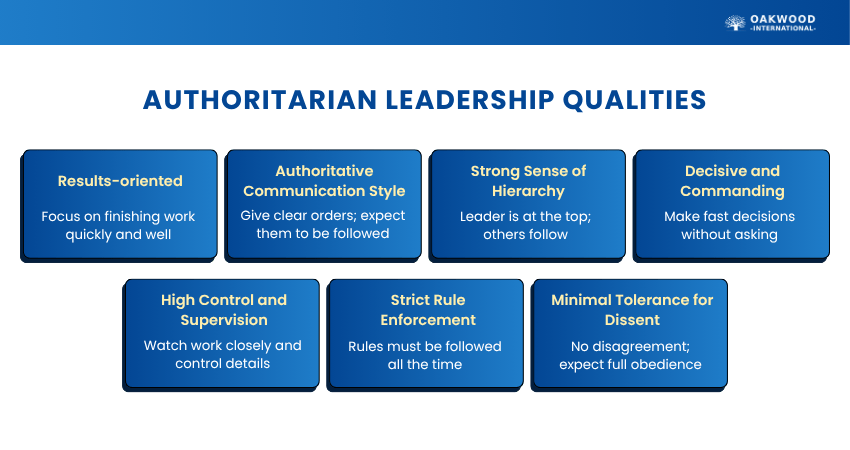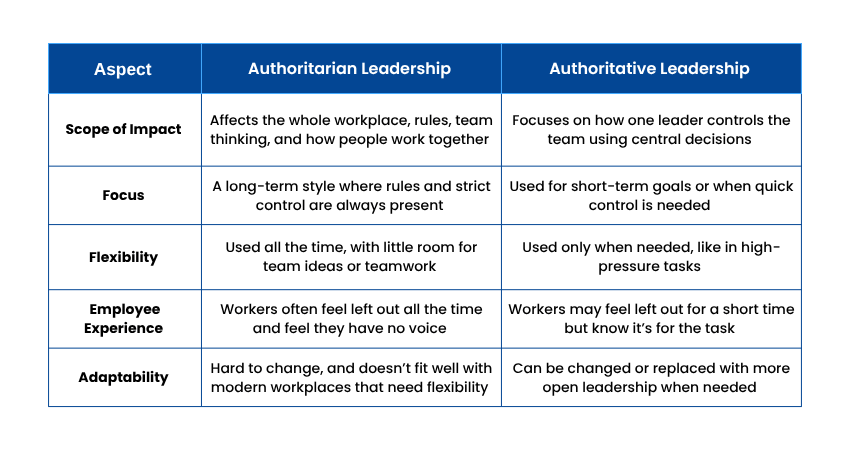Table of Contents


Your team is facing tight deadlines, confusion is rising, and decisions are stuck in endless back-and-forth. In moments like these, a leader who takes full control, gives clear instructions, and cuts through the noise can be exactly what’s needed. This is where Authoritarian Leadership steps in, offering structure, speed, and strong direction when the situation demands it.
It’s a style where control reigns supreme, and the leader’s word is law. While it may sound rigid, this approach has its place in high-pressure environments where quick, decisive action matters most. In this blog, we’ll explore what Authoritarian Leadership is, its key traits, pros and cons, how it differs from authoritative leadership, and where it works best, or not. So, read on!
What is Authoritarian Leadership?
Authoritarian Leadership is when one person makes all the decisions for a team, group, or organisation. This leader stays in full control and doesn’t ask others for ideas or suggestions. People who work under this leader are expected to follow strict rules and not question anything. The leader wants everyone to agree and do what they are told without thinking differently.
This style is about keeping order, following rules, and doing work fast. It is good when quick action is needed, like in the army, hospitals, or big factories. But it can stop new ideas and teamwork in modern, flexible workplaces.
Characteristics of Authoritarian Leadership
In Authoritarian Leadership, leaders like to stay in control and make all the decisions. Here are the main characteristics of the Authoritarian Leadership style in very simple words:

1) Results-oriented
These leaders focus on completing tasks quickly and accurately. They push the team to meet targets and finish work on time, believing that success means delivering high-quality results without delay.
Example: A Factory Manager who ensures all products are produced on time, free from defects, and meet quality standards.
2) Authoritative Communication Style
They speak in a firm, clear voice and give direct instructions. They expect others to listen and do what they say without asking questions. They don’t like long talks or team discussions.
Example: A military commander who gives orders and expects soldiers to follow immediately without any questions asked.
3) Strong Sense of Hierarchy
They believe the leader should be at the top, and everyone else must follow. Everyone has a fixed role. They want employees to respect their position and not challenge it.
Example: A CEO who is the boss and expects all Managers and workers to follow their instructions.
4) Decisive and Commanding
They make decisions quickly and stick to them. They lead with confidence and take full control. They don’t ask others before choosing what to do.
Example: A fire chief who makes fast decisions during emergencies without asking others for any help.
5) High Control and Supervision
They watch the team’s work very closely. They want to know everything that is happening. They like to be involved in every small detail.
Example: A Project Manager who checks every step of the work and controls how tasks are done.
6. Strict Rule Enforcement
They believe rules must always be followed. If someone breaks a rule, they may be warned or punished. They think rules help keep everything in order.
Example: A school principal who makes sure all students follow school rules strictly every single day.
7) Minimal Tolerance for Dissent
They don’t like it when people disagree or say “no.” They want full obedience. They feel disagreement slows down the work and creates problems.
Example: A team leader who expects everyone to agree and follow instructions without questioning.
Elevate your management career with our CMI Level 4 Diploma in Management and Leadership – Join now!
Benefits of Authoritarian Leadership
These are the advantages of Authoritarian Leadership:
1) High Productivity and Efficiency
Work is completed faster because only one person makes decisions. There’s no need to wait for lengthy discussions or meetings, which saves time and keeps the team focused and on schedule.
2) Strong Organisational Structure
This leadership style has clear roles and order. Everyone knows who the leader is, who gives tasks, and who does the work. This structure keeps the team organised and working well.
3) Consistency in Work Quality
In Authoritarian Leadership, one leader controls everything, the work is done the same way every time. This makes the quality of work steady and reliable. There are fewer mistakes and changes.
4) Effective Crisis Management
In difficult or emergency situations, quick action is important. The leader can act fast without waiting for others. This helps resolve problems quickly and keeps the employees and the team safe.
5) Clear Direction
This leadership style has a clear structure. Everyone knows who the boss is and what their job is. There is no confusion because the leader gives clear instructions to everyone. Henry Ford and Ferdinand Karl Piëch, giants of the automobile industry, were known for their authoritative leadership style.
Drawbacks of Authoritarian Leadership
These are the disadvantages of Authoritarian Leadership:
1) Creativity and Innovation Suffer
These leaders do not want new ideas from the team. People are scared to share their thoughts. This stops the team from being creative or trying better ways to work.
2) Fear-based Work Culture
The leader uses strict rules and control. People feel scared to speak up or say something is wrong. This makes the team unhappy and quiet.
3) Inflexibility in Leadership
Authoritarian leaders don’t like change. They don’t listen to feedback. This makes it hard to work with modern teams that want new ways to do things.
4) Micromanagement
Authoritarian leaders often watch every detail. They don’t let workers do tasks on their own. This can stop employees from learning, and growing, and may make them unhappy or bored.
5) Poor Communication
In this style, the leader talks and others just listen. If the leader doesn’t share enough or explain clearly, the team may miss important information. This can cause confusion and mistakes.
6) Lack of Employee Engagement
Only the leader talks. Workers feel they are not heard or valued. This makes them lose interest and just do the bare minimum.
Are you ready to influence and inspire? The CMI Level 5 Award in Management and Leadership is your gateway to advanced leadership - Sign up now!
Examples of Authoritarian Leaders
Examples of famous people who practice Authoritarian Leadership can be found in numerous sectors. Here are some prominent ones:

1) Richard Nixon: He was known for making all the big decisions by himself.
2) Lorne Michaels: He runs “Saturday Night Live” and is known for choosing everything that goes into the show without asking others.
3) Bill Gates: In the early days of Microsoft, he made most of the big decisions on his own.
4) Margaret Thatcher: She was the UK leader and made big decisions alone.
5) Steve Jobs: He was the boss at Apple and told people what to do.
6) Winston Churchill: He led Britain in the war and gave clear orders.
7) Elon Musk: He runs Tesla and SpaceX and makes fast decisions.
Most leaders in the U.S. don’t use this style all the time. They only use it when the situation needs it. It often depends on the type of job or company.
How to Succeed with Authoritarian Leadership
Authoritarian Leadership can be effectively used in situations requiring rapid decision-making and strong control. It must be wisely managed for keeping workplace environment positive. Some ways to succeed with Authoritarian Leadership are mentioned below:
1) Hear Your Team’s Input
Although the final decision lies with the Authoritarian Leader, allow employees to share thoughts and concerns. Through active listening, team members will feel valued and respected. It can give you valuable insight for strengthening decisions and fostering a healthy workplace culture.
2) Set Clear Guidelines
Directions need to be followed diligently under Authoritarian Leadership. This means teams must clearly understand what their roles and responsibilities are. By establishing clear guidelines, transparent communication and setting standards, confusions can be prevented and teams can be aligned towards one goal.
3) Equip Teams with the Right Tools
It is crucial for every team member has relevant skillset, knowledge and tools for completing their tasks. In case of any gaps, provide necessary training, support and guidance to help them succeed. This helps to empower teams, improve performance and minimise burnout.
4) Demonstrate Consistency
For having other people follow your footsteps, stand by the rules you set and follow them through your actions. When you maintain standards and lead by example, your team will respect your authority and follow rules willingly.
5) Acknowledge Achievements
If you focus solely on team member’s mistakes, it can result in demotivation and discouragement. Always acknowledge your team’s achievements and celebrate them. Through appreciation, moral is boosted, efforts are encouraged and feedbacks are easier to accept.
Authoritarian vs Authoritative Leadership: Key Difference
People often confuse authoritarian and authoritative leadership because both involve strict control and one person making decisions. These are some key differences between Authoritarian Leadership vs Authoritative Leadership.

Conclusion
Authoritarian Leadership is a strict style where one person makes all the decisions and expects others to follow. While it offers clear direction and fast results, it may reduce teamwork, creativity, and employee happiness. This style works best in emergencies or high-pressure settings but may not suit modern workplaces. Leaders should use this leadership style wisely, depending on the team’s needs and the situation.
Advance your leadership career with our CMI Level 4 Training - Join now!


 Back
Back



 Back to Catagories
Back to Catagories





 + 44 7452 122728
+ 44 7452 122728










